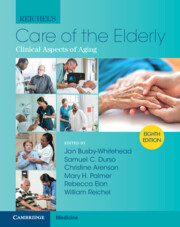Book contents
- Reichel’s Care of the Elderly
- Reichel’s Care of the Elderly
- Copyright page
- In Memoriam
- Contents
- Contributors
- Section I General Approach to the Care of the Elderly
- Section II Geriatric Syndromes
- Section III Care of the Elderly by Organ System
- Section IV Principles of Care for the Elderly
- Chapter 46 Surgical Principles
- Chapter 47 Rehabilitation
- Chapter 48 Geriatric Sexuality
- Chapter 49 Aging in Adults with Intellectual Disabilities and Severe and Persistent Mental Illness
- Chapter 50 Home- and Community-Based Long-Term Care
- Chapter 51 Institutional Post-Acute and Long-Term Care Medicine
- Chapter 52 Hospital-Based Care
- Chapter 53 Introduction to Palliative Care
- Chapter 54 The Mistreatment of Older Adults
- Chapter 55 Driving and the Older Adult
- Chapter 56 Integrative Medicine
- Chapter 57 Retirement
- Chapter 58 Cultural Competence
- Chapter 59 Health Literacy
- Chapter 60 Caregiving
- Chapter 61 Practice Transformation for Better Care of Older Adults
- Chapter 62 Health-Care Organization and Financing
- Chapter 63 Ethical Decision-Making
- Chapter 64 Epidemic and Pandemic Impacts on the Elderly Population
- Index
- Plate Section (PDF Only)
- References
Chapter 52 - Hospital-Based Care
from Section IV - Principles of Care for the Elderly
Published online by Cambridge University Press: 30 June 2022
- Reichel’s Care of the Elderly
- Reichel’s Care of the Elderly
- Copyright page
- In Memoriam
- Contents
- Contributors
- Section I General Approach to the Care of the Elderly
- Section II Geriatric Syndromes
- Section III Care of the Elderly by Organ System
- Section IV Principles of Care for the Elderly
- Chapter 46 Surgical Principles
- Chapter 47 Rehabilitation
- Chapter 48 Geriatric Sexuality
- Chapter 49 Aging in Adults with Intellectual Disabilities and Severe and Persistent Mental Illness
- Chapter 50 Home- and Community-Based Long-Term Care
- Chapter 51 Institutional Post-Acute and Long-Term Care Medicine
- Chapter 52 Hospital-Based Care
- Chapter 53 Introduction to Palliative Care
- Chapter 54 The Mistreatment of Older Adults
- Chapter 55 Driving and the Older Adult
- Chapter 56 Integrative Medicine
- Chapter 57 Retirement
- Chapter 58 Cultural Competence
- Chapter 59 Health Literacy
- Chapter 60 Caregiving
- Chapter 61 Practice Transformation for Better Care of Older Adults
- Chapter 62 Health-Care Organization and Financing
- Chapter 63 Ethical Decision-Making
- Chapter 64 Epidemic and Pandemic Impacts on the Elderly Population
- Index
- Plate Section (PDF Only)
- References
Summary
As Medicare has focused more on hospital readmissions and care transitions over time, programs and movements aimed at providing geriatric-focused care have developed nationally. These programs aim to minimize and prevent hazards of hospitalization, decrease readmissions, provide safer transitions to the post-acute setting, and decrease length of stay while acknowledging and addressing specific care considerations of hospitalized older adults, such as dementia, sensory impairment, and mobility impairment. Inpatient geriatric assessments help providers tailor care plans to the specific needs of individual hospitalized older adults and determine their post-acute care needs, and also help with appropriate counseling of family and caregivers. Prevention measures are vital during hospitalization of older adults, who are at higher risk of delirium, pressure injury, falls, aspiration, malnutrition, sleep disturbances, and venous thromboembolism. Detailed transition plans and specialized discharge summaries are important to highlight the needs of older adults as they transition to post-acute care settings, and should allow for providers to resume the care plan seamlessly, including continuation of advanced care planning conversations.
Keywords
- Type
- Chapter
- Information
- Reichel's Care of the ElderlyClinical Aspects of Aging, pp. 641 - 649Publisher: Cambridge University PressPrint publication year: 2022

